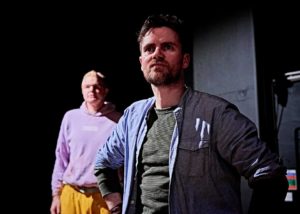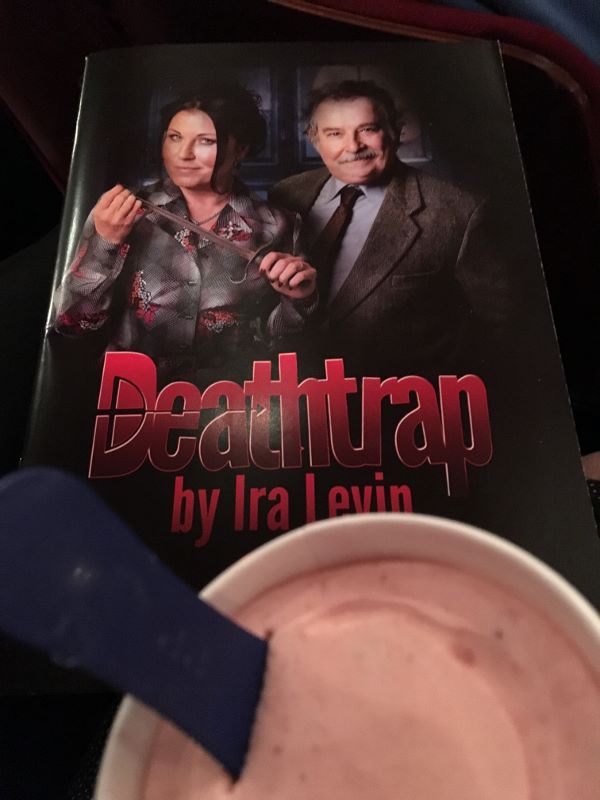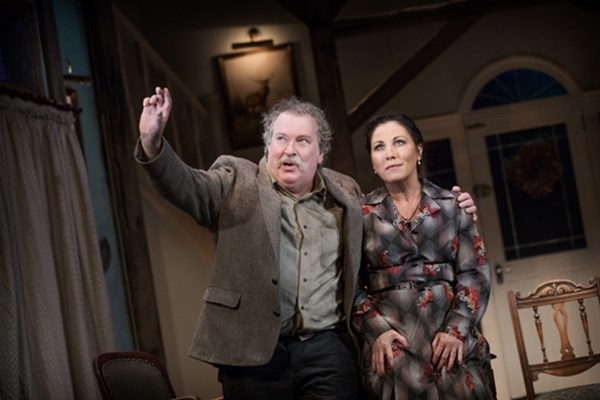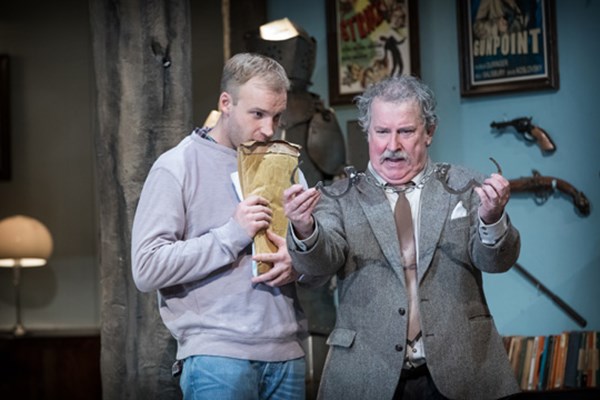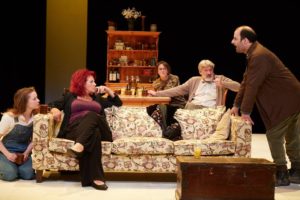
This is not a new version of the Chekhov classic, but a ‘re-imagining’ by Welsh writer Gary Owen, of Killology & Iphigenia In Splott fame. Owen relocates it from 1890’s Russia to the Pembroke coast in 1982, just prior to the Falklands War, which makes for a very interesting choice.
It feels like every dysfunctional family drama you’ve ever seen, until you realise Chekhov originated the idea of real characters, with real problems, talking like real people.

Family matriarch Rainey, who has crawled into a bottle after the death of her son over a decade ago, followed soon after by the suicide of her husband, is virtually dragged back to the family home from London by Anya, her youngest daughter. Her self-destructive lifestyle has lead to the family home on the Pembroke coast being auctioned off to pay the debts.
Val, her eldest daughter, has held things together, but they need Raynie’s permission (and signature) to save it. All agree that the only viable option is to sell off the ancestral cherry orchard for redevelopment, but will she see it that way?
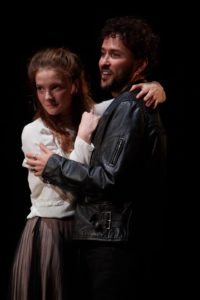
This play is incredibly funny and well-worth seeing, if only for the way Owen makes it so accessible to Welsh eyes. The ‘Russian peasants’ now come from housing estates, the decaying aristocracy are English interlopers, and the Communist revolutionaries are now Thatcherites, sweeping the past away without a thought or concern.
At the heart of the play is the idea that the future is farther away than we hope, while the past is always closer than we’d like. The characters here are continually haunted, not by spirits, but by the ghosts of memories, taunting them with remembrance.

Rainey tries to forget through excess, her guilt at losing her son gnawing away at her, like a rat sown inside her skin. In the end it causes her to take drastic action, and Denise Black brings all this out in a masterful performance that makes you feel sorry for her, even while she’s being a monster to all and sundry.
The entire cast take their moments when offered, yet still make this a true ensemble piece. Morfydd Clark is sweetly sensual as the young Anya, while Hedydd Dylan as her elder sister Val, shows us a woman who tries to run other people’s lives, but fails at her own.

Simon Armstrong as Gabe, Rainey’s brother, is amusingly ineffectual, yet quietly sharp. When Val talks about Rainey not telling him about her plans to leave he replies “We’ve been brother & sister half a century. Through awful things. Do you think saying ‘goodbye’ makes any difference?”
Alexandria Riley gives us a Dottie that is down to earth yet shows the love/hate relationship she has with the family, while Richard Mylan is funny, while also imparting a wise naïveté to Ceri.
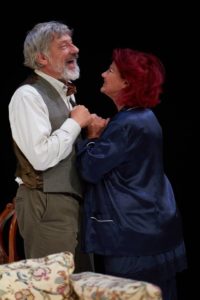
Mathew Bulgo, given the task of Lewis, the ‘poor boy made good’, effects a performance of subtlety that defies the historical villain the role has been seen as. With the insults he endures from the others, and denied the role of ‘family saviour’ by Rainey, it’s hard not to feel sympathy for him.
Writer Gary Owen conveys a situation full of layers, and also offers some nice ironies. Ceri’s expectations of Margaret Thatcher getting the blame for the Falklands War being one, Gabe’s job offer as an investment banker another.
When you add all this to Rachel O’Riordan’s deft direction, Kenny Miller’s intriguingly skewed set, and Kevin Tracey’s ingenious lighting, the Sherman Theatre demonstrates yet again that it is punching well above its weight in the theatre world.
There is so much going on here that I actually re-read the script in one go afterwards, and was still as gripped as I was by seeing it. The play is funny, ironic, witty, sarcastic and quietly heartbreaking. It is a story of loss, of people, places and things, and how memories both haunt and define us.
As F. Scott Fitzgerald once observed: ‘We beat on, boats against the current, borne back ceaselessly into the past‘.
http://www.shermantheatre.co.uk/performance/theatre/the-cherry-orchard/

Kevin Johnson
Tag Archives: Review
Review Of Mice and Men, August 012 by Troy Lenny
All photographs credit Studio Canno
 (4 / 5)
(4 / 5)
Of Mice and Men is a story of loneliness and misunderstandings. I remember studying this literary art in high school, but I didn’t notice the finer details, only the outline.
On Wednesday I watched Of Mice and Men presented by August 012, at Chapter ArtCentre. The outline of the story is two friends, George Milton and Lennie Small who are two workers in the Great Depression. To escape their cruel reality they share a distant dream that persuades them they will own their and land, “an’ live of the fat of the land.” This dream swirls colours of great happiness into their lives.
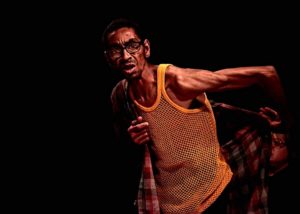
I do not want to cut curiosity out of the plot, so I will express little of this element. There are two stern problems blocking their dream. Lenny has an intellectual disability, and naively often strokes problems at work. And George and Lennie need ‘stake’ (money) from work so they can whirl their dream into reality.

I rate this production four stars. Why? Because the production was extraordinary. It had a partial modern theme which drew out the connection that many of the problems in Of Mice and Men still exist today, if you thin your eyes. Additionally, the production style conflates imagination with reality through dreamy description and because the audience’s seats are placed on an empty stage an immersive reality surrounds you (plus you may be able to play cards with the characters!)

I would recommend anyone reading this to book a ticket, and visit the world Of Mice and Men because its performance style will enlighten tenebrous learnings. One element of the production I noticed during this production was all of the characters were Greatly Depressed, but they wiped their tears and some tried to smile and others frowned. For example: Callous Curley, always had a curled fist most likely because he felt lonely, but due to his expected masculine role he couldn’t express his feminine emotions so he was always steaming frustration. Consequently, Curley’s wife felt lonely, and wandered looking for company and due to expected feminine roles she likely thought the only way to attract a man’s attention was by swirling hips.

I would like to thank all involved in the production Of Mice and Men for their creative minds, and extraordinary performance style – it was striking.

Troy Lenny
Review Goodbye Christopher Robin by Jonathan Evans
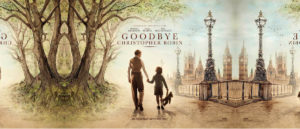
 (3 / 5)
(3 / 5)
Goodbye Christopher Robin is, at the start, about the rejuvenating ability that thinking as a child can help people through dark times and then becomes about the corruption of success and fame.
We are introduced to A.A. Milne (Domnhnall Gleeson) who has survived the First World War but is shell shocked and angry at the world. He lives rather comfortably in London with his wife Daphne (Margo Robbie) but he cannot get over the trauma, he introduces one of his plays but the spotlight reminds him of the lights in the trenches and cannot get through it. In his disgruntled state he decides to move his wife and son (Will Tilston) out to the country.
Whilst there Milne seems to be much more interested in woodwork and walking rather than writing. Daphne grows ever more bored and frustrated so she leaves for some city time, coinciding with her leaving the nanny (Kelly MacDonald) must also go for three days to see to her sickly mother. So now its just the two of them.
During the time they are away it falls on Milne to step up and take care of his son. He is not the most patient man so they have tension in deciding what breakfast to make and him needing quite. But he gets sucked into the world his son creates with his stuffed toys. We then hear other names and phrases and can connect the dots that these elements will be used to tell the tale we all know.
He of course writes it down and is a tremendous success. But with success comes fame so he is constantly being called and asked to make appearances. Even Milne, who wrote the book is always asked about his son. Public appearances, signings, interviews all in abundance. He can hardly go anywhere and not be recognized. Even in their country home people come looking for him.
Being that this is about the behind the scenes story of a popular work of fiction I couldn’t help but think of Finding Neverland and Saving Mr Banks. Out of all of these movies the best one is Finding Neverland but this is also a different movie. It shows the damaging effects of too much fame for someone that cant handle it.
This is a very handsomely shot movie with attention to detail in the living areas, wardrobe and the sunlight having a truly golden quality to it.
The movies message is a simple one and the story of what when on with the people behind the material is interesting. A few moments of cool transitions, attractive production value and very solid performances help make it more worth seeing it those elements weren’t there.
Review: Layton’s Mystery Journey by Sian Thomas
![]()
This review contains spoilers.
Trailer for Layton’s Mystery Journey: https://www.youtube.com/watch?v=hFz1tTNNRkM
As far as anyone was concerned this time in the last two years, the Professor Layton series was over. There were games and a movie and a book, and then it was finished. I remember how I felt the day some concept art snaked its way on to my timeline, and how incredulity and unimaginable excitement swelled in me: my absolute favourite series was still going. Some higher ups had decided not to leave us all the way that they had. How could I not be beside myself with utter glee? How could me, my friends who I met because of this series, how could we not let ourselves be absolutely encompassed by this incredibly lucky turn of events? We were so happy. I was so happy.
Layton’s Mystery Journey follows Katrielle Layton, Professor Layton’s daughter as she opens her own detective agency and solves a number of cases for London’s elite millionaires – the “Seven Dragons”. What I also thought was going to happen was throughout these cases, Katrielle would undergo the ongoing case of her father’s disappearance, since this is what I’d discovered was the #1 talking point whenever I looked into the game. “Professor Layton is missing! Will his daughter find him?” I thought she would.
As a series that existed differently to the previous Layton games, I obviously expected change. A new cast, new voices, new music, new scenery. I knew it was coming, so when it arrived there were no ill feelings between it and me. Much as how people say, “The movie would be good on it’s own” when the book was better but the movie was… okay… I can say that if this series didn’t have links to the older version, it would have been okay – it would have been good on it’s own. In some places it was even nice – to see things newly imagined. But my view was always going to be rose-tinted because of the old games, so I was helpless.
Some things were good. The music was good, but Layton music always has been (here’s a taste of this game’s music! : https://www.youtube.com/watch?v=4czbYlei3GY&list=PLVfglvX_VlEZniKUW5NEcdC_yaK6CipuV ). The puzzles were okay (since after all, it is a puzzle game), and I do appreciate that they existed as a tribute to the person who used to make the puzzles for these games, Akira Tago (1926-2016).
There was one character I did really love – Pipper Lowonida, the fictional Mayor of London (pictured on the right, below). She was the first character I saw! The concept art that found itself on my timeline was of her, and I always thought I’d like her. I was right! She’s the Mayor, but with a flare for festivals and parties, and with a happy and witty attitude. She was the best part of the game for me.

So, there was some good things. Not many, though, because now I have the chance to get into what really got under my skin.
This is something I realised a few weeks ago. I found myself less excited for Layton’s Mystery Journey as some of the other people I new. I thought maybe I had exerted it all too early, I thought the funny little online puzzle game (http://www.layton.jp/mystery-journey/laytonworld/uk.html) had depleted it (since I never finished it, and fell out with it just after it began). But, nope! It was something else entirely. I found myself reflecting on the prequel and sequel trilogies of the original Layton series, I found myself thinking quietly on how I loved their plots and characters until I stumbled on a big flaw. Lately with media I have been more than a little picky. Representation and mature story handling has become incredibly important to me, and I realised that the Layton series actually wasn’t ticking any of my important check boxes. Representation in terms of race? It wasn’t happening. Representation in terms of sexuality? Also wasn’t happening. In the original series there was one character who didn’t appear white – and he turned out to be a bad guy (bad move! Especially when this was the only non-white character of an entire series consisting of 7 games and one movie). This carried through into Layton’s Mystery Journey, unfortunately. There was one character who appeared non-white, yet his name was “Shadee” (it’s exactly what you’re thinking), and he was the main culprit of a case that our main characters were pursuing. They were pursuing him harshly, treating him badly, and didn’t apologise when they realised he wasn’t the culprit. (Bad move! It’s 2017 for goodness sake, show some compassion).
There’s also no representation when it came to sexuality. Heteronormative things came through easily in the past series (marriage, nuclear families, a young girl who gives a young boy a kiss and everyone in the vicinity giving each other those knowing looks even though the two kids in question were 11 at best), and this new game (the sidekick character, Ernest Greeves, is blatantly infatuated with the main character Katrielle. She doesn’t notice, and when she doesn’t another character is compelled to say things like “throw him a bone”, “give him a chance”. The problem I have with this is: Girls should not be prompted/feel obliged to appease a man just because the man in question has feelings for them. They shouldn’t have their independence and potential character growth thwarted just because a man has shown up and shown interest). Nothing about characters who weren’t straight, even though it is 2017. It’s disappointing, realising a series you love will not break the safe and traditional mould.
The last point? Every single plot of every single Layton game – and the movie – exists because of women’s suffering. This is a trope I do not at all like: “Woman gets hurt to unlock a man’s story”. So over the ten years that Professor Layton content has been being produced, it’s been the same story: a woman is hurt, somehow. A man’s story comes into existence because of this. So that’s all 6 original games, the crossover game, the movie, and this game! That’s bad. 9 times, a company can’t break from this storytelling? For ten years a company will keep themselves glued to this harmful storytelling? As the times change and representation and better treatment of female characters is needed and they do nothing? Yeah, I’m not exactly happy.
For this game, and for a long time, I really did not think they were going to fall into this trope. But they did, and it was right at the very end of the game. Turns out the bad guy was only propelled forward into taking the actions he did because his mother died. For this game I thought that, what with a new female protagonist, Level5 (the company behind the series) would be shepherded into treating their female characters better, but no. They don’t. They even forgive the antagonist, and move on like nothing ever happened. A white male character isn’t held accountable for his actions, but an NPC who appears black is lambasted endlessly through the case and treated poorly even if they did nothing wrong? I’m disappointed, massively so.
Continuing from that, here’s another of my big issues for the game: it is, as far as I’ve seen, hinged on the premise of “Professor Layton is missing – will his daughter, Katrielle find him?” And here let’s get into some big things that really made my blood boil: They barely mentioned this in-game. They barely talk about how the professor is missing, and when they do, it is off-handed mentions, vague information, and a flippant way of injecting it into the game as if no one really cares that this is the “overall plot” people were expecting. So, no, if you’re wondering, they don’t find the Professor. They don’t even look for him. There aren’t even hints throughout the 12 cases of this game that they plan on searching for him. Which is, let’s face it, a disappointment. I don’t know why advertising seemed to encircle this and then they go ahead and barely use it. I can understand that it’s likely to set up for a second game (which I don’t think I’ll be buying after my revelations and experiences with this game), but really what it felt like was laziness. A lack of a want to finish a story they led people to believe would be solved for the sake of making more money on the next instalment. Worse, they hinge a cutscene at the very end of the game in the post-credits, where it’s revealed that the main character, Katrielle, may not even be Layton’s daughter. She says she has solved the riddle Professor Layton left her (“If you’re not my daughter, then who are you?”). Some people took this as a good cliffhanger, but I took this as a slap in the face and the regrettable loss of £33.
I didn’t like it. Others may, and that’s fine, but Professor Layton content is no longer my cup of tea. I didn’t enjoy it and eventually trudging through playing it started to feel like a chore. Obviously I’m sad, I waited so long for this and was so excited and now I’m shrugging off a franchise I’ve loved for ten years. Hopefully this is better for me. With the fall of this, I just hope I can find better content I can throw myself into as deeply as I did this. Overall, I’m massively disappointed. One star.
Review The Rise and Fall Of Little Voice, Theatr Clwyd by Karis Clarke
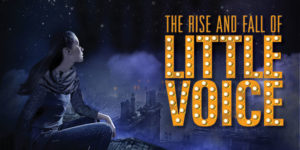
 (4 / 5)
(4 / 5)
As a critic I am not technically minded, I view a play and my mind will automatically focus on the acting ability of the cast , as my background is in performing. However it would be impossible not to be blown away by the genius set design and the technicality of this production.

Using a revolving room on a split level, and a dividing floor the design by Amy Jane Cook easily managed to give the illusion of an open dolls house. (If the dolls house was a northern council house with poor electrics and bad house keeping!) This enabled the lounge, kitchen diner and bedroom all to be in full view of the audience. With swift transitions the bedroom revolved, the living room divided and the set transformed to Mr Boo’s night club. The first transition took place just after the beginning of the second half and was met with suitable gasps of awe from the impressed full house.

It would be rude not to give credit to the lighting design, by Nicholas Holdridge although naturalistic in nature a majority of the play took place in dimly lit rooms and at one point darkness. However the clever use of street, moon, dawn and torch light ensured the actors were always well lit and the tone and atmosphere were heightened. This combination of stage and technical magic combine in the final stages of the production, not wanting to spoil the effect -Theatre Clwyd’s production does stay true to the film and they do so very effectively. A combination of smoke, lights movement and LV’s impressions as she reaches breaking point culminates to an intense stage experience.

The cast were as impressive as the set, comic timing, physicality and delivery were strong. Each member of the small ensemble allowed each other to have stand out moments as well as ensuring they all worked well together to perform some very funny dialogue, comedic banter and duets. (watch out for Nicola Reynolds, Mari Hoff, LV’s mum and the brilliant Victoria John, Sadie, the down beaten neighbour performing “It’s Raining Men”)
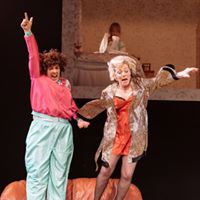
This play can only work if LV can actually deliver the impressions stated – ergo this play works. It has been stated on social media that when Catrin Aaron sings its like Judy Garland is in the room. I fully agree – except Shirley Bassey, Marilyn Monroe and a host of others are there with her.

I was slightly disappointed with some of the direction of the play, continuity of stage exits occasionally seemed haphazard – this could be due to them being sacrificed for the technicality of the production – in which case I can forgive the occasions when walls are walked through – however towards the end of the play it felt like the cast had forgotten where doors were and they were just walking wherever!
Jim Cartwright’s script is undoubtedly witty and gritty and is supposed to be full of hilarity and vulgarity, however, I was waiting for the all important point when I would feel empathy with the characters, for me, it didn’t happen. I put this down to the direction of Wasserberg rather than the acting ability of the cast. It was played for laughs and in doing so the characters became more caricatures – that although I laughed with, I never fully connected with.
Other than this, it was a pleasure to watch, strong female leads and the standing ovation was justly deserved. Little Voice hits the right notes.
Theatre Clwyd, Antony Hopkins Theatre,Tuesday 10th October . Directed by Kate Wasserberg
Review Deathtrap, New Theatre, Cardiff by Jane Bissett.
DEATHTRAP
By Ira Levin
 (2 / 5)
(2 / 5)
Deathtrap is the age old story of a man who wants more than he has and is prepared to go to any lengths to gain it.
The action takes place at the home of playwright Sidney Bruhl’s home that he shares with his wife of 11 years, Myra.
We see Sidney, a man who has not written a successful play for a number of years receives a manuscript from a aspiring young playwright. This is the opening of a plot that will change the course of the lives of Sidney and Myra in ways that we, the audience, will not have imagined.
The story covers four weeks in the life of Sidney Bruhl where he, Sidney, plans and plots to create a better life for himself at any cost.
The three main characters played by Paul Bradley (Sidney Bruhl), Jessie Wallace (Myra Bruhl) and Sam Phillips (Clifford Anderson), despite all being well known to us in former stage and television roles, were believable and I particularly liked Wallace’s portrayal of Myra Bruhl.
Despite not being familiar with the story and not having seen any other adaptation I didn’t find it as thrilling as I had anticipated. There were a lot of question marks about the relationships between the characters which were never addresses in either dialogue or behaviour except for the ending of act one. This isolated engagment between characters didn’t actually appear to have any relevance to the storyline and left the audience somewhat confused. Perhaps it was meant to shock? Either way it really didn’t work.
That said, the outstanding performance for me was Beverley Klein. She gave a wonderful performance as Helga ten Dorp, the Bruhl’s psychic neighbour. Her portrayal of ten Dorp single-handedly brought the thrills, drama and humour to the stage and was a delight to watch.
The set design worked well and the lighting created an atmosphere for day and night that worked particually well. The sound was spot on and certainly on cue for the moments we all jumped out of our seats! It would be unfair to elabarate further as it would certainly create a spoiler for anyone going to see the play.
Scene changes were prompted by the showing of vintage thrillers on screen in black and white which worked to great effect and enhanced the experience. The video design which was by Duncan McLean gave a sort of scrap book feel to the presentation and perhaps gave an insight to the mind of a thriller writer, their inspiration and method of work?
DEATHTRAP plays at Cardiff’s New Theatre from;
Tuesday 10 October – Saturday 14 October at 7.30pm
Wednesday, Thursday and Saturday Matinees at 2.30pm.
For further details or to book tickets call the Box Office on 02920878889.
Review Rip it Up, St David’s Hall by Barbara Hughes Moore

Dreamboats and Petticoats: Strictly stars tear up the dancefloor in Rip It Up
Having attended a fair few live shows featuring the Strictly cast, I can safely say that Rip it Up ranks among the best of them. Inventive, energetic and invigorating, Rip it Up was created, crafted and choreographed by fan favourite Strictly pro Natalie Lowe. Having recently left BBC’s flagship dance show after seven years (to the distress of many SCD fans, myself included), Natalie has shifted her considerable skill towards the theatre, being both the brains and brawn behind this 1950s-set dance spectacular. Joining her on tour are Strictly champions Jay McGuiness and Louis Smith, who lifted the glitterball with Aliona Vilani in 2015 and Flavia Cacace in 2012 respectively.
Directed by Gareth Walker, Rip it Up (named for one of the 50s songs it incorporates) follows the three principals and a slew of equally brilliant backing dancers as they shake, rattle and roll their way through some of the decade’s greatest songs – moving with ease from Elvis to Little Richard to Sam Cooke and Ritchie Valens. I’d forgotten how good these songs were, and how fabulous they are to dance to – but the considerable, combined talents of the Rip it Up ensemble brought it all back to me.
The show was split into different segments, each encapsulating a different type or trend of 50s music: rock ‘n’ roll, vocal harmony, blues, ballads, and Latin, as well as specific tributes to Buddy Holly, Elvis Presley, Little Richard and the Rat Pack. It was exhausting enough reading through the setlist, let alone watching the dancers perform to them! Natalie described the ensemble as the hardest working out there, and I certainly agree. Nothing was spared or suppressed – hearts and souls were bared on the dancefloor that night, and the audience was loving every second.
It was particularly gratifying to be a part of an audience that was as responsive to the show as I was – so often in modern theatre audience reaction is muted and formal, but just as the performers were giving every drop of energy and enthusiasm they had, so too were the people watching from their seats. Jay kindly acknowledged the audience response, thanking us for ‘making Monday night feel like Saturday night’. Well, Jay and the rest of the cast certainly made a rainy night in 2017 Cardiff feel like a summer’s day in 1955 NYC.
To enhance the feel of the time period, there was a brief TV montage interlude between each dance segment, showcasing some of the 50s’ cringiest commercials – including a toy advert for a truly bizarre sort of hula-hoop worn on the head called a ‘Swing Wing’, which was no doubt responsible for causing widespread whiplash during the decade. These were intercut with the ensemble’s pre-filmed cutesy interpretations of the era, as well as entertaining asides from the master of ceremonies, Leo Green, who also doubled as band leader and saxophonist.
Speaking of the music, the classic 50s hits were played with emotion and aplomb by a five-piece band, and what a joyful noise they made with so few. Along with Leo’s superb sax, we were treated to Ed Richardson on drums, Ian Jennings on bass, Jonny Dyke on keyboards and Matt White on guitars. I can’t stress how excellent the musicians were, including the two primary singers of the piece: Oliver Darling (who sported Buddy Holly glasses during his tribute) and Jill Marie Cooper, an exclusive treat for Cardiff audiences. They not only captured the spirit of the songs, but of the generation – although at times, they did tend to belt ballads that could have done with a softer touch. A small price to pay for the marvellous music overall – I would happily have paid to see the musicians and singers alone, but here they enhanced and accentuated the equally wonderful work of the dynamic dancers.
Natalie Lowe embodied the charm and elegance of the era, seamlessly slipping from Grace Kelly-esque screen siren to Elvis-like leather-clad rock ‘n’ roller, and countless other characters in between. She utterly evoked the ingenue of her introductory song, Jackie Wilson’s Reet Petite (‘the finest girl you ever want to meet’). Her standout number was a beautiful ballroom show-dance to the Righteous Brothers’ Unchained Melody, as well as a cheeky jive to a medley of 50s jitterbug. Not to mention she was responsible for overseeing and choreographing everyone else, and ensuring that every part had a unique and different feel, facet and flair. Her exit is a loss to Strictly, but a magnificent gain for the stage, and I can’t wait to see what she has waiting in store for us next.
Supporting our superb leading lady were two highly capable, and yet incredibly different, leading men: Jay McGuinness, whose unique brand of cool, chivalrous charm embodied the era’s sweetness simmering beneath the surface; and Louis Smith, whose fiercely flirtatious brand of fun complemented Jay extremely well. They couldn’t be less alike, except in their attempts to vie for Natalie’s affections, alternately foxtrotting and jiving their way into her heart. For two Strictly champions who had both been unfairly criticised by the judges for their supposed lack of personality during their tenure, it was particularly satisfying to see Jay and Louis not only having improved since their deserved wins, but infusing their routines with so much character, confidence and flair. They fit in perfectly alongside the pros, and skilfully held their own alongside them.
Jay’s entrance was the most impressive by far. Clad in black from head to toe, he spun around in the shadows and de-hatted himself, giving the impression that he had appeared out of thin air. He certainly encapsulated the gung-ho gusto of his intro song, Jerry Lee Lewis’ Great Balls of Fire. He also demonstrated a wide range of theme, technique and emotion (as he had done on Strictly), performing with passion and panache in every style of dance from waltz to cha cha and an artsy modern number to Nat King Cole’s Unforgettable that evoked his winning show-dance. And, of course, his jive prowess were second to none, as it has been ever since he and Aliona’s Pulp Fiction tribute broke the internet. Jay didn’t just shine whilst dancing; he also graced us with lovely renditions of some of the staple songs of the 50s, including the incomparably classy Beyond the Sea and a sultry rendition of Sway. Out of all the Strictly champions, Jay has the greatest potential to take the West End by storm – singing, dancing, acting, what can’t he do? I hope his recent stint as the lead in Big! The Musical is the first of many in a long line of stage shows in Jay’s future.
Louis, last but certainly not least, leapt onto the stage to Little Richard’s Tutti Frutti; from start to finish he looked like he was having the most fun by far – and that’s really saying something in an altogether joyous production. Although Louis performed in Strictly alum Robin Windsor’s Keep Dancing tour at Cardiff’s New Theatre last year, and has improved even since through joining Rip it Up, he confessed he hadn’t been sure if he could or should carry on dancing in live productions. But after a great experience with Natalie, Jay and the gang (and some vehement audience encouragement), it (thankfully) looks as though Louis isn’t going to hang up his dancing shoes any time soon. He looked as though he lived every moment of every dance, and possessed the most vibrant personality and stage presence of the entire ensemble. His gymnastics skills always shone during his Strictly stint, but here he has honed his dance technique and performance into sophisticated and stylish perfection. He excelled in solo, partner and group dances, really capturing the mischievous, rebellious feel of the era and starring in some of the strongest set-pieces: a sulky, sultry number to Peggy Lee’s Fever was a particular highlight, as well as a geeky romance against the backdrop of Sam Cooke’s Wonderful World. Louis’ Strictly journey keeps evolving, and long may it continue – Cardiff will certainly be there to welcome him back to the stage in the future.
If ever a stage show was an ensemble success, that show is Rip it Up. Every single backing dancer performed to the same superb standard as the principals and musicians, and were given ample time to shine both alongside and separate from the three leads, yet another testament to the team spirit of the entire production. Though the set itself was sparse, the performers and costumes made up for the minimal production values (totally understandable on a tour budget). However, despite how impressive the three leads’ solo numbers were, I would have loved to have seen the three of them sharing the stage more often. Natalie, Louis and Jay appeared together to bookend each segment, but then split up to perform numbers in which they individually featured (accompanied by partners or backing dancers), but rarely with one another. Because of the rarity of their onstage collaboration, one of the standout numbers for me was Jay and Louis engaging in what I can only refer to as a ‘James Dean-Off’ in which the two Strictly champs did their damned-est to out-Brando each other in rolled-up jeans and white Ts. In a similar vein, I think there should have been a story running through the show (just as Vincent and Flavia often have in their live shows); in doing so, they could build on the natural flirtation between Natalie, Jay and Louis, and incorporate their love triangle into a more structured through-line. It would have added a narrative cohesion to the excellent dance numbers, rendering them not only exciting but necessary in advancing the plot and our leads’ love lives.
Overall, Rip it Up is a truly wonderful theatrical experience that I urge anyone with even the vaguest interest in dance, music, theatre, The Wanted or gymnastics to go to if humanly possible. It’s great to see familiar faces again, as well as discovering new ones, and I can’t wait to see where Natalie, Jay, Louis and company go from here – I only hope that they keeeep dancing
http://www.stdavidshallcardiff.co.uk/whats-on/dance/rip-it-up/
Review The Mountain Between Us by Kevin Johnson

An interesting but flawed idea, two strangers survive a plane crash in the mountains, get to know each other as they try to walk out of the frozen wilderness, and begin to fall in love.
Idris Elba shows his star quality by holding his own against Kate Winslett. They have chemistry, and full marks for casting an interracial couple, but it doesn’t quite work.
Films like this drive me mad, because they’re so close to being brilliant, but fall short. The scenery, mostly snowy mountains, is amazing, the music is good, as is the direction, with some innovative touches. The script, however, lets everyone down.
Elba is an emotionally constipated neurosurgeon, Winslett a maverick photojournalist, both are strong-willed yet it’s she who drives them on while he wants to play it safe. So far, so good.
What could then have been developed into an interesting character piece, starts to unravel. Winslett keeps moaning about her poor fiancé, whilst the plight of the ten year old patient Elba was supposed to operate on is ignored.
It doesn’t help that the film is divided into ‘before and after’ section, which means the ending gets bogged down in romantic cliches that dilute the emotional momentum from before. There’s even a sex scene which, although beautifully filmed, jars with the story.
The film falls between two stools, neither a romance nor a survival thriller, although it tries to be both. Not a bad film though, just not a great one.
Oh and there’s a cute dog.
Review One Man, Two Guvnors, Black RAT Productions by Helen Joy
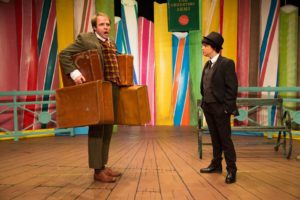
A slapsticky ribtickling romp through Mr Bean’s homage to the Italian original.
I love this theatre company. They make me laugh. Properly head back gasping for breath laugh. This multi talented bunch of actors and their production team are properly good.
I love the venue. I love the welcome. The busyness of the place. The swirly carpets and the polished wood and the atmosphere of years of local folk heading here for a night out. Marvellous.
And marvellous to take a glass of wine into the theatre and settle into your seat whilst the cast play their way through a series of ‘60s songs, washboard ‘n’ all. A band which reforms for set changes – how delightful, how clever to keep us all singing and clapping along.

Never afraid to look you in the eye, to include you in the action, to keep you alive with the threat of putting you too on the stage, it’s bright and buzzing throughout.
And the lead, Francis Henshall, is, quite frankly, fabulous! A tweedy oaf with a lust for food and a hunger for love, he draws us in, right in.
But he wouldn’t be half so good without his sidekicks.
Every character is perfectly overblown and overplayed. Exaggerated, exaggerating, they are funny and likeable and strangely believable. All very special in their own sweet Brighton rock kinda way.
Every seat is filled. Everyone is laughing. Everyone is having a very good time.
There is an energy to this production which drives through to the end.
Nothing unpredictable, nothing too challenging but what a wonderful slapsticking backslapping suitcase swapping utterly joyous night out!
Black Rat Productions is an extraordinarily talented company. There to be enjoyed.
One Man, Two Guvnors is a play by Richard Bean, an English adaptation of Servant of Two Masters (Italian: Il servitore di due padroni), a 1743 Commedia dell’arte style comedy play by the Italian playwright Carlo Goldoni.
Helen Joy for Get the Chance, 3rd Act Critics.
A Black RAT Productions, Blackwood Miners’ Institute and RCT Theatres co-production supported by Arts Council Wales
Cast
Gareth John Bale … FRANCIS HENSHALL
Lee Gilbert … HARRY DANGLE
Phylip Harries … CHARLIE CLENCH
Sarah-Jayne Hopkins … DOLLY
James Lawrence … STANLEY STUBBERS
Daniel Miles … ALAN DANGLE
Caryl Morgan … RACHEL CRABBE
Alice Strachan … PAULINE CLENCH
Chris Tummings … LLOYD BOATENG
Production Team
By Richard Bean
Based on The Servant of Two Masters by Carlo Goldoni
With songs by Grant Olding
Directed by Richard Tunley
Designed by Anna Marie Hainsworth
Production Manager / Lighting Design Robin Bainbridge
Stage Manager Claire Roberts
Musical Director Rob Thorne
Review Uncle Vanya, Theatr Clwyd by Donna Poynton
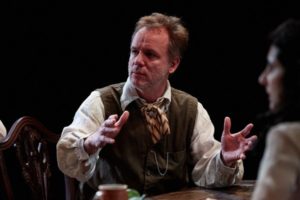
Uncle Vanya was first published in 1897 and had its premiere in Moscow in 1899, performed by the Moscow Art Theatre under the direction of Konstantin Stanislavski.
The play focuses on the visit of an elderly professor and his young wife Elena to the rural estate which supports their city dwelling lifestyle. Two friends, Vanya-the brother of the professor’s late first wife and the controller of the estate and Astrov-the local doctor, both end up falling for the charms of Elena. Sonya, the professor’s daughter by his first wife, is hopelessly in love with the doctor but her feelings are unmatched. Tempers flare and drama ensues as the professor announces his plans to sell the estate allowing Vanya to spiral into a madness offering tormented bawling and even a gunfight!
This new production written by Peter Gill and directed by Tamara Harvey of Chekhov’s doom-tinged comedy is set in the round, allowing for the feeling of immersion as an audience member, particularly during each characters’ soliloquy. We feel we are let in on the action, surrounding the players; close emotionally as well as physically. Each scene cleverly switches from outside to in and we are treated to some glorious pieces of silent acting as the characters themselves subtly manoeuvre the set to allow transitions (for example we hear claps of thunder and rainfall and a handful of actors swiftly grab chairs and rugs to ‘save them from getting wet’). The design of the piece, in this way, is very simple and yet we could look so much further into its meaning. Throughout the entire production there is an overhanging tree which could have been placed simply to remind us where we are. Could it, on the other hand, be symbolic of the overhanging, inevitable destruction in the piece?
The destruction of man and oneself is reflected in the frequent discussions of the desolation of the Earth’s forests. We cannot fail to spot the implications that humankind may not be KIND at all and that the dissatisfaction in our lives comes not only from ones own failings but from the failings of others to encourage success and happiness. We see love in all forms; love for family (as much as we may often speak ill of them or even wish then ill!), the love of nature, love of home, romantic love and even love unrequited but it appears that love brings with it sadness, frustration, sorrow and even utter despair!
Despite this, the play provides many moments of humour-mainly gleaned from the excellent characterisation of the title character by Jamie Ballard who portrays Vanya with just the right amount of comedy and tragic poise. This production has been cast superbly but special mention must also go to Rosie Sheehy as Sonya who plays the innocence and the pain of unreturned love beautifully, to Shanaya Rafaat as Elena who we are able to empathise with despite her somewhat ignorant demeanour and Oliver Dimsdale as Astrov who is both physically and mentally handsome-the stage often brought to life with each appearance.
This production of Uncle Vanya allows the stunning properties of Chekhov’s text to be fully appreciated as part of an up to date design. Despite it keeping its original 1890s setting we are able to relate the themes of the piece to our modern lives.

